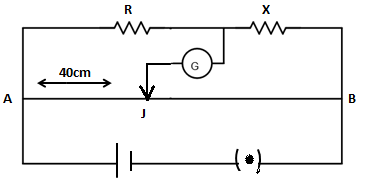
Write the principle on which the working of a meter bridge is based. In an experiment on meter bridge, a student obtains the balance point at the point J such that, as shown in figure. The values of R and X are both doubled and then interchanged. Find the new position of the balance point. If the galvanometer and battery are also interchanged how will the position of balance point be affected?

Answer
204.6k+ views
Hint: Meter Bridge is the simplest practical application of Wheatstone bridge. Initial balance point of Wheatstone bridge substitute in the balance equation. By doubling the value of R and X in the balance equation, a new balance point is calculated.
Complete step by step answer:
Meter bridge working is based on the principle of Wheatstone bridge. After taking out a suitable resistance R from the resistance box, the jockey is moved along the wire AB till there is no deflection in the galvanometer. This is the balance condition of the Wheatstone bridge. If P and Q are the resistance of the parts AJ and JB of the wire, then for the balanced condition of the bridge, we have
\[\dfrac{P}{Q} = \dfrac{R}{X}\]
Now, let us write the information given in the question.
Balance point\[AJ = 40cm\], now R and X are doubled and interchanged then the new balance point we have to find.
Let us use the balancing condition for Wheatstone bridge \[\dfrac{P}{Q} = \dfrac{R}{X}\]
Initial balance point is 40cm.
\[\dfrac{R}{X} = \dfrac{{40}}{{100 - 40}} = \dfrac{{40}}{{60}}.....\left( 1 \right)\]
Now, according to the question, when the vales of both the X and \[R\]are doubled and interchanged, the balance point (L) is calculated below.
$\Rightarrow$ \[\dfrac{{2X}}{{2R}} = \dfrac{L}{{100 - L}}....\left( 2 \right)\]
Let us equate equation (1) and (2).
$\Rightarrow$ \[\dfrac{{40}}{{60}} = \dfrac{L}{{100 - L}}\]
Taking cross multiplication we get,
$\Rightarrow$ \[60L = 40\left( {100 - L} \right)\]
On multiply the bracket term and we get,
\[60L = 4000 - 40L\]
Let us subtract we get,
\[ \Rightarrow L = 40cm\]
Hence, the new balancing point is the same as earlier.
If the galvanometer and battery are also interchanged there will be no effect on the position of balance point.
Note: The deflection of galvanometer not getting affected by interchanging position of battery and galvanometer. In a slide wire, if a balance point is obtained at L cm from the zero ends, then the unknown resistance X is calculated as by below expression.
$X = \dfrac{{\left( {100 - L} \right)}}{L}R$
Complete step by step answer:
Meter bridge working is based on the principle of Wheatstone bridge. After taking out a suitable resistance R from the resistance box, the jockey is moved along the wire AB till there is no deflection in the galvanometer. This is the balance condition of the Wheatstone bridge. If P and Q are the resistance of the parts AJ and JB of the wire, then for the balanced condition of the bridge, we have
\[\dfrac{P}{Q} = \dfrac{R}{X}\]
Now, let us write the information given in the question.
Balance point\[AJ = 40cm\], now R and X are doubled and interchanged then the new balance point we have to find.
Let us use the balancing condition for Wheatstone bridge \[\dfrac{P}{Q} = \dfrac{R}{X}\]
Initial balance point is 40cm.
\[\dfrac{R}{X} = \dfrac{{40}}{{100 - 40}} = \dfrac{{40}}{{60}}.....\left( 1 \right)\]
Now, according to the question, when the vales of both the X and \[R\]are doubled and interchanged, the balance point (L) is calculated below.
$\Rightarrow$ \[\dfrac{{2X}}{{2R}} = \dfrac{L}{{100 - L}}....\left( 2 \right)\]
Let us equate equation (1) and (2).
$\Rightarrow$ \[\dfrac{{40}}{{60}} = \dfrac{L}{{100 - L}}\]
Taking cross multiplication we get,
$\Rightarrow$ \[60L = 40\left( {100 - L} \right)\]
On multiply the bracket term and we get,
\[60L = 4000 - 40L\]
Let us subtract we get,
\[ \Rightarrow L = 40cm\]
Hence, the new balancing point is the same as earlier.
If the galvanometer and battery are also interchanged there will be no effect on the position of balance point.
Note: The deflection of galvanometer not getting affected by interchanging position of battery and galvanometer. In a slide wire, if a balance point is obtained at L cm from the zero ends, then the unknown resistance X is calculated as by below expression.
$X = \dfrac{{\left( {100 - L} \right)}}{L}R$
Recently Updated Pages
JEE Main Candidate Login 2026 and Registration Portal | Form Access

Household Electricity Important Concepts and Tips for JEE

JEE Main 2023 (January 31st Shift 1) Physics Question Paper with Answer Key

Clemmensen and Wolff Kishner Reduction - Important Concepts and Tips for JEE

JEE Main Maths Paper Pattern 2026: Marking Scheme & Sections

JEE Main 2023 (April 11th Shift 2) Physics Question Paper with Answer Key

Trending doubts
JEE Main 2026: Application Form Open, Exam Dates, Syllabus, Eligibility & Question Papers

Atomic Structure: Definition, Models, and Examples

JEE Main Exam Marking Scheme: Detailed Breakdown of Marks and Negative Marking

Angle of Deviation in a Prism – Formula, Diagram & Applications

Hybridisation in Chemistry – Concept, Types & Applications

JEE Main 2026 Session 1 Form Correction – Procedure, Fees & Editing Guidelines

Other Pages
JEE Advanced Marks vs Ranks 2025: Understanding Category-wise Qualifying Marks and Previous Year Cut-offs

JEE Advanced 2025: Dates, Registration, Syllabus, Eligibility Criteria and More

Equation of Trajectory in Projectile Motion: Derivation & Proof

Collision: Meaning, Types & Examples in Physics

Average and RMS Value in Physics: Formula, Comparison & Application

How to Convert a Galvanometer into an Ammeter or Voltmeter




